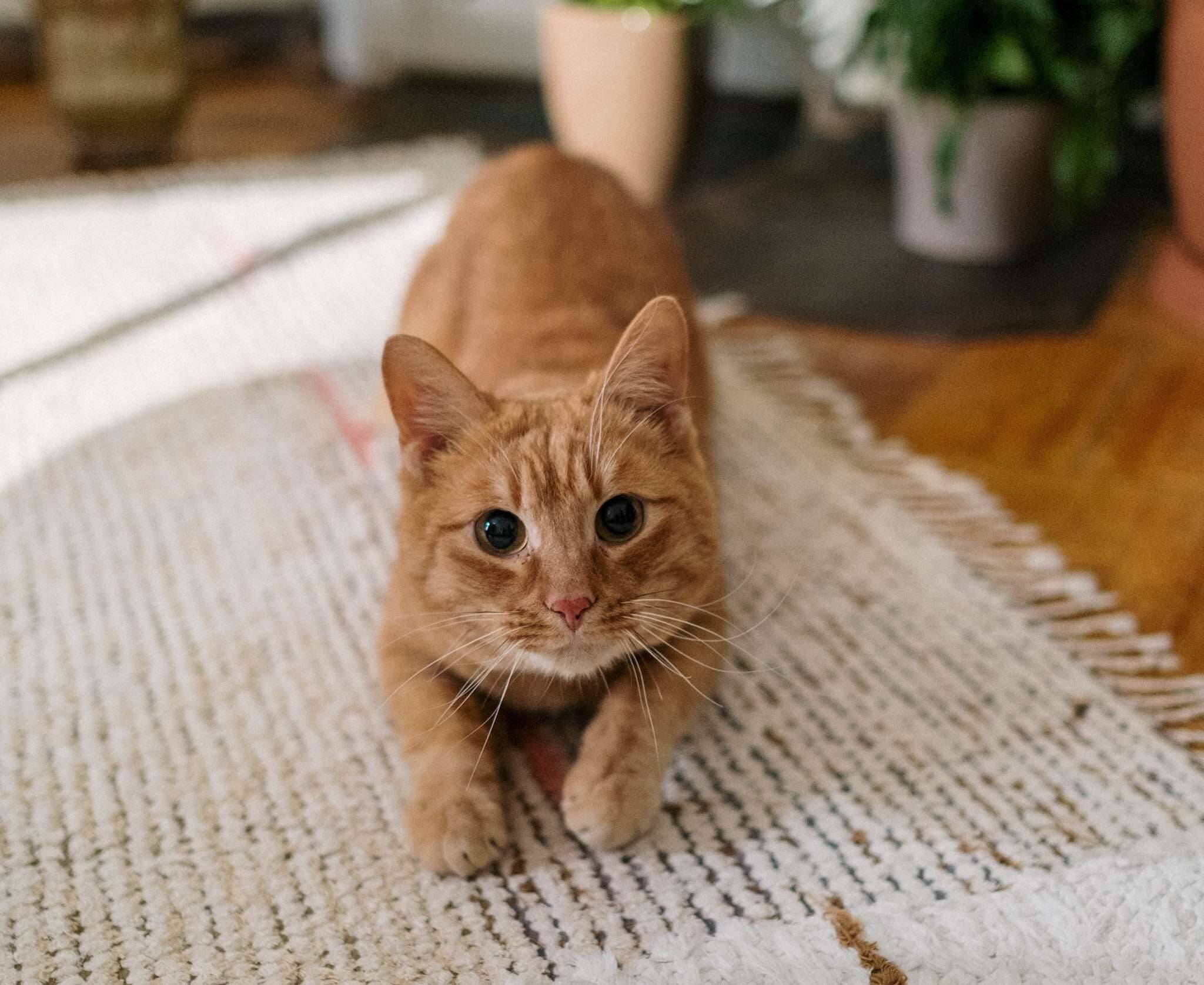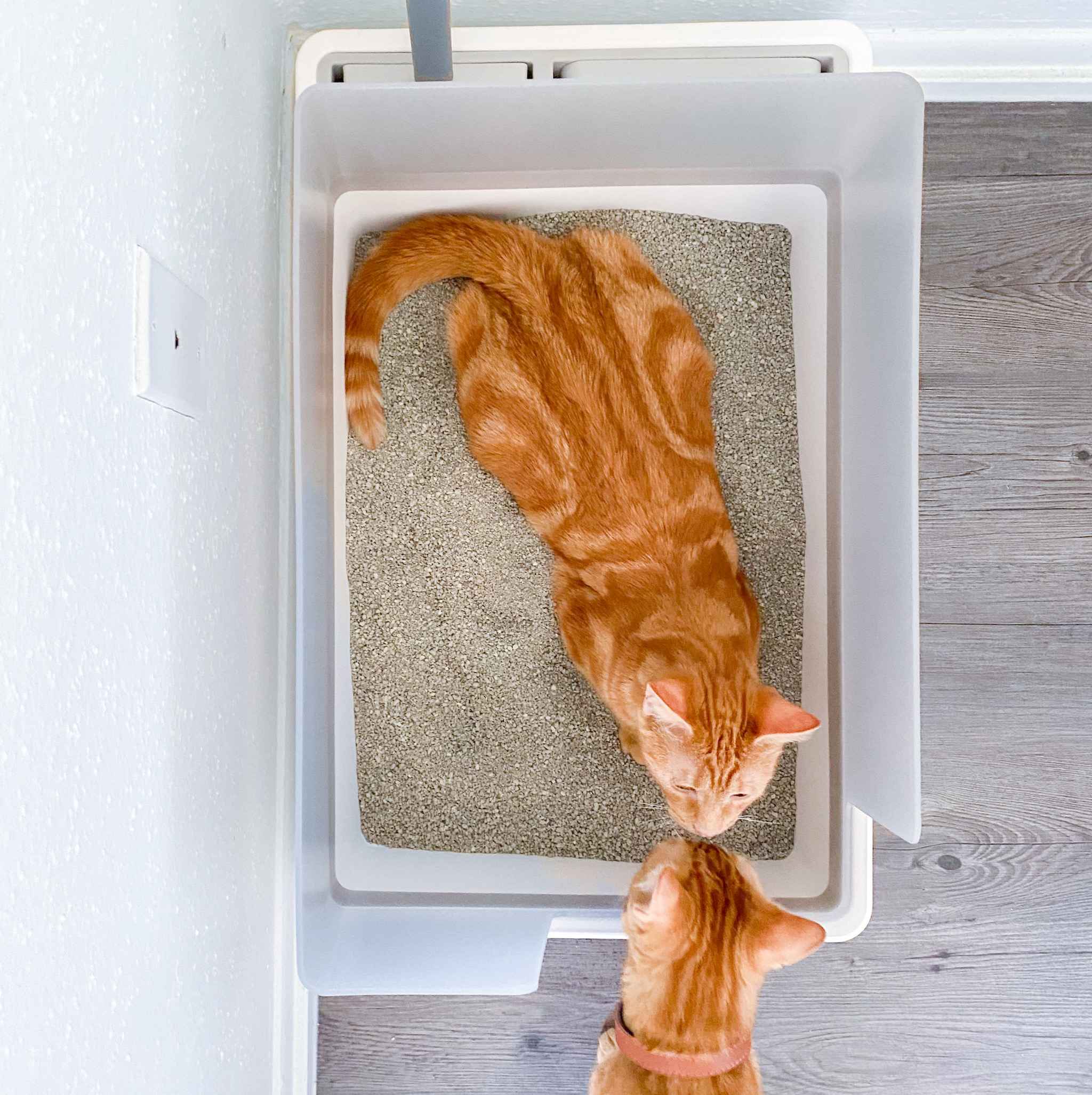We all love cats, but their instinct to scratch can sometimes lead to frustration for cat parents, especially when they direct their efforts to your beloved carpet. In this comprehensive guide, we'll delve into the reasons behind this feline behavior and explore effective strategies on how to prevent your cat from scratching the carpet. With a little understanding and the right approach, you can preserve your carpets and keep your cat happy.
Here at tuft + paw, we are cat experts. The information in this article is based on consultation with a veterinarian, cat behaviorist, extensive online research, and our own experience as cat parents.
Tip: If you’re on the lookout for stylish cat scratching alternatives to your carpet, check out our list of the best modern scratching posts.
Cheat Sheet: How to Stop Your Cat From Scratching the Carpet
|
Why Do Cats Scratch the Carpet?
Understanding the underlying reasons for your cat's carpet-scratching habit is the first step toward addressing this behavior. Cats have several motivations for this seemingly destructive act:
Maintain Their Claws
Cats scratch to keep their claws healthy and sharp. It's a way for them to shed the outer sheath of their claws, exposing the fresh, sharp nail underneath. Much like licking their fur, it’s a grooming behavior that contributes to their overall health. Outdoors they’ll often use trees for this purpose, but in our homes they usually opt for fabric surfaces like carpets and upholstered furniture (and occasionally table legs). The best scratching posts will replicate this satisfying experience and help with claw maintenance.
 Tab Scratching Board by tuft + paw - Shop Here Credit: @foreverkarnold
Tab Scratching Board by tuft + paw - Shop Here Credit: @foreverkarnold
Mark Their Territory
Scratching is a form of communication for cats. When they scratch, glands in their paws leave scent marks which are unique to each cat. They also leave physical scratch marks which serve as a visual signal. This combination of scent and visual marks their territory and communicates their presence to other cats.
Stretch Their Muscles
Cats stretch their bodies as they scratch. It's a way to maintain their flexibility and exercise their muscles (plus it just feels good). Cats usually prefer large surfaces for scratching so they can stretch their entire body—another reason why the carpet is a great option for them. This is why we recommend tall scratching posts, so cats can adequately stretch when scratching.
 Frond Cat Tree by tuft + paw - Shop Here
Frond Cat Tree by tuft + paw - Shop Here
Energy + Stress Outlet
Scratching provides an outlet for excess energy and can be a stress-reliever for cats. It's a way for them to unwind and alleviate anxiety. Cats may scratch when they're excited or happy (e.g. when you come home from work), but they may also scratch when they’re feeling stressed or understimulated (e.g. when they don’t get enough exercise).
Natural Instinct
Lastly, scratching is a deeply ingrained natural instinct in cats. It's not something they do to annoy their owners; it's simply a part of being a cat. You can’t stop your cat from scratching any more than you can stop them from eating or sleeping. Understanding this is the first step to solving unwanted scratching behaviors.
You need to redirect your cat’s scratching, not stop it.
How to Stop Your Cat From Scratching the Carpet
Now that we've explored the reasons behind your cat's carpet-scratching behavior, let's discuss effective strategies to redirect this behavior in a positive way.
1) Get a Scratching Post
The first thing to do is provide a scratching alternative! If your cat is consistently scratching the carpet, provide a horizontal carpeted scratching board to replicate that experience. Always take your cat's preferences into account: they're telling you what they like to scratch!
Whether you get a vertical or horizontal scratching post, make sure it's long/tall enough for your cat to stretch comfortably. If your cat doesn’t take to the first scratching post, try some other materials or designs to see what their preferences are (tip: most cats love sisal rope/fabric). Sometimes all it takes is some trial and error to fix the problem.
Place the scratching post on top of (or at least close to) their carpet scratching spot to make it as attractive as possible and really send home the message that "this is for scratching!" The scratching post should be as accessible as possible.
2) Encourage Your Cat to Use the Scratching Post
Encourage your cat to use the scratching post by incorporating it into your cat's playtime. Try scratching it yourself while your cat's watching to demonstrate how to use it. This process may take some time, so be patient and consistent. Anecdotally, one cat parent on our team got a new scratcher for their cat and it took several weeks of daily playtime before the cat started using it on their own. Cats move at their own pace!
3) Reward Your Cat For Scratching the Post
Positive reinforcement goes a long way in training your cat. Whenever you see your cat using the scratching post, praise them and offer a treat or affectionate petting. This associates the scratching post with positive experiences.
Whatever you do, don't force your cat onto the scratching post or get mad at them for not using it. This will just create negative associations and make them avoid it.
4) Use Attractants + Deterrents
Catnip or cat attractant spray can be applied to the scratching post to make it more appealing to your cat. Feliway even has a product called Feliscratch, which is designed for this purpose.
Conversely, you can use cat deterrent sprays on the carpet to make it less enticing. These products use scents that cats dislike, like citrus or herbal smells. There are also pheromone sprays like Feliway Classic, which calms cats down and prevents them from marking the sprayed area.
5) Cover the Scratched Area
If your cat has a particular spot on the carpet they favor, consider temporarily covering it with a plastic mat, double-sided tape, or aluminum foil. Cats dislike these textures and will be discouraged from scratching. You can also cover the spot with furniture or, even better, a scratching post!
Note: Never cover your cat’s scratching spot without providing an alternative. This will just stress them out and they’ll find a new spot to scratch.
 Zip Scratching Post by tuft + paw - Shop Here
Zip Scratching Post by tuft + paw - Shop Here
Other Tips for Preventing Your Cat From Scratching the Carpet
In addition to the strategies mentioned above, here are some more tips to help you put an end to your cat's carpet-scratching tendencies:
Never Punish Your Cat!
Never punish your cat for scratching the carpet. They won't understand why they’re being scolded, and this can lead to stress and hurt your cat-human bond. Redirecting their behavior with scratching alternatives and positive reinforcement is far more effective. Be patient and consistent.
Trim Your Cat’s Claws
Regularly trimming your cat's claws can reduce the damage they do to your carpet. Be sure to watch tutorials or ask your vet before attempting to trim their claws yourself. Trim their claws when they’re sleepy, taking care to only trim the points and not cut to the quick (the pink interior with nerve endings and blood vessels). Reward them afterwards with love and a treat for their good behavior.
Give Your Cat Lots of Love
A happy and content cat is less likely to engage in destructive behavior. Spend quality time with your cat, provide toys for mental stimulation, and ensure they have a comfortable and engaging environment. Play with them for fifteen minutes every day to give them exercise and an outlet for all that energy.
Clean the Carpet to Remove Scent Marks
Use mild detergent and water to remove the scent marks left by your cat's scratching. This can help break the cycle of unwanted scratching, especially when paired with a scratching post and positive reinforcement to redirect their efforts.
Stabilize the Scratching Post
Make sure the scratching post is stable and won't wobble when your cat uses it. A wobbly post can deter your cat from using it. Cats prefer a solid surface which they can really dig their claws into and pull against (hence why they like carpets and couches). This is why we recommend scratching posts with wide bases or wall mounts. We don’t recommend hanging scratching posts because they don’t provide the stability needed for a good hard scratch.
@eatsleepmeow Can you tell they love their scratch post? #fyp #foryou #foryoupage #cat #cats #catsoftiktok #kitty #kitten #tuftandpaw @tuftandpaw ♬ original sound - Patty b
Give Each Cat Their Own Space
If you have multiple cats, provide each with their own scratching post and territory. Cats can be territorial, and having their own space can reduce conflicts. This also ensures that wherever a cat is in the house, they’re close to a designated scratching surface.
Train Kittens to Use Scratchers
Start early with kittens and train them to use scratching posts with positive reinforcement. It's easier to establish good habits when they're young, rather than breaking bad habits when they’re older.
If All Else Fails, Try Nail Caps
If the methods above haven’t solved the scratching problems, consider using nail caps for your cat. These are plastic coverings applied to a cat's claws to prevent them from causing damage when scratching. They don’t hurt the cat and are retractable. However, nail caps have some downsides. Nail caps…
- Inhibit your cat from properly taking care of their claws.
- Affect how cats walk and balance.
- Reduce a cat’s ability to defend themself.
- Can be pulled off and eaten.
- Only last 4-6 weeks.
Given these downsides, we don’t recommend nail caps as a first option. In certain circumstances, they can be a temporary measure while trying to develop healthier scratching behaviors.
Remember: scratching is a healthy cat behavior that should be encouraged! It’s up to cat parents to provide healthy outlets for scratching.
Never Declaw Your Cat!!
As cat lovers and parents ourselves, we firmly believe that cats should not be declawed! It’s a procedure which essentially disables your cat, and can cause them lots of pain. A cat’s claws are more like fingertips than human nails, in the sense that cats rely on them for sensation and interacting with the world around them.
Scratching is a healthy, normal behavior for cats, so we encourage all cat parents to try the methods above rather than declawing their cat.
Conclusion
Stopping your cat from scratching the carpet requires patience, understanding, and the right tools and techniques. Remember that scratching is a natural behavior for cats, and your goal is not to suppress it entirely but to redirect it to more appropriate surfaces. By following these strategies and offering your cat a stimulating and comfortable environment, you can enjoy a scratch-free carpet and a happy, contented cat.





